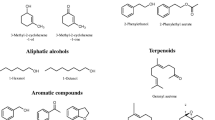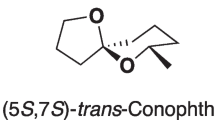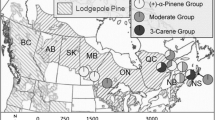Abstract
Antennally active, bark-derived, angiosperm volatiles were tested singly and in groups for their ability to disrupt the response of the Douglas-fir beetle (DFB), Dendroctonus pseudotsugae, to attractant-baited multiple-funnel traps. One compound, conophthorin, was active alone in reducing the response of beetles to the baited traps. Further experiments showed disruptive activity in two aliphatic green-leaf alcohols [1-hexanol and (Z)-3-hexen-1-ol], as well as guaiacol and benzyl alcohol, and three aliphatic aldehydes [nonanal, hexanal, and (E)-2-hexenal] but not in two aromatic aldehydes (benzaldehyde and salicylaldehyde). Every binary combination that included conophthorin or any two of the other groups, except aromatic aldehydes, significantly reduced the response of beetles to baited traps. Various ternary mixtures and the complete mixture of all the groups were generally the most effective treatments. These results provide evidence that DFBs recognize and avoid nonhosts while flying rather than landing on candidate hosts and testing them while in contact with the tree. Nonhost angiosperm bark volatiles may have practical utility on their own or in combination with the antiaggregation pheromone 3-methylcyclohex-3-en-1-one (MCH) to protect single trees, logs, or stands from attack by the DFB.
Similar content being viewed by others
REFERENCES
BIRGERSSON, G., DEBARR, G. L., DE GROOT, P., DALUSKY, M. J., PIERCE, H. D., JR., BORDEN, J. H., MEYER, H., FRANCKE, W., ESPELIE, K. E., and BERISFORD, C. W. 1995. Pheromones in the white pine cone beetle, Conophthorous coniperda(Schwarz) (Coleoptera: Scolytidae). J. Chem. Ecol.21:143-167.
BORDEN, J. H., CHONG, L. J., SAVIOE, A., and WILSON, I. M. 1997. Responses to green leaf volatiles in two biogeoclimatic zones by striped ambrosia beetle, Trypodendron lineatum. J. Chem. Ecol.27:2479-2491.
BORDEN, J. H., WILSON, I. M., GRIES, R., CHONG, L. J., PIERCE, H. D., JR., and GRIES, G. 1998. Volatiles from the bark of trembling aspen, Populus tremuloidesMichx. (Salicaceae) disrupt secondary attraction by the mountain pine beetle, Dendroctonus ponderosaeHopkins (Coleoptera: Scolytidae). Chemoecology8:69-75.
BYERS, J. A., ZHANG, Q.-H., and SCHLYTER, G. 1998. Volatiles from nonhost birch trees inhibit pheromone response in spruce bark beetles. Naturwissenschaften85:557-561.
DALLARA, P. L., SEYBOLD, S. J., FRANCKE, W., and WOOD, D. L. 1994. The chemical ecology of Pityophthorus Eichhoff(Coleoptera: Scolytidae) in central coastal California, Appendix, pp. Ixviii-Ixix, inD. H. Adams, J. E. Rios, and A. J. Storer (eds.). Proceedings, 43rd Anual Meeting of the California Forest Pest Council, Rancho Cordova, California.
DAY, R. W., and QUINN, G. P. 1989. Comparisons of treatments after an analysis of variance in ecology. Ecol. Monogr.59:433-463.
DEGLOW, E. K., and BORDEN, J. H. 1998a. Green leaf volatiles disrupt and enhance response by the ambrosia beetle, Gnathotrichus retusus(Coleoptera: Scolytidae) to pheromone-baited traps. J. Entomol. Soc. BC.95:9-15.
DEGLOW, E. K., and BORDEN, J. H. 1998b. Green leaf volatiles disrupt and enhance response to aggregation pheromones by the ambrosia beetle, Gnathotrichus sulcatus(Coleoptera: Scolytidae). Can. J. For. Res.28:1697-1705.
DICKENS, J. C., BILLINGS, R. F., and PAYNE, T. L. 1992. Green leaf volatiles interrupt aggregation pheromone response in bark beetles infesting southern pines. Experientia48:523-524.
FRANCKE, W., HINDORF, G., and REITH, W. 1978. Methyl-1,6-dioxaspiro[4,5]decanes as odors of Paravespula vulgaris(L.). Angew. Chem. Int. Ed. Engl.17:862.
HUBER, D. P. W., GRIES, R., BORDEN, J. H., and PIERCE, H. D., JR. 1999. Two pheromones of coniferophagous bark beetles (Coleoptera: Scolytidae) found in the bark of nonhost angiosperms. J. Chem. Ecol.25:805-816.
HUBER, D. P. W., GRIES, R., BORDEN, J. H., and PIERCE, H. D., JR. 2000. A survey of antennal responses by five species of coniferophagous bark beetles (Coleoptera: Scolytidae) to bark volatiles of six species of angiosperm trees. Chemoecology. In press.
HUMPHREYS, N. 1995. Douglas-fir beetle in British Columbia. Forest Pest Leaflets. Natural Resources Canada, Canadian Forest Service. Cat. No. Fo 29-6/14-1995E.
KOHNLE, U., DENSBORN, S., KöLSCH, P., MEYER, H., and FRANCKE, W. 1992. (E)-7-Methyl-1,6-dioxaspiro[4.5]decane in the chemical communication of European Scolytidae and Nitidulidiae (Coleoptera). J. Appl. Entomol.114:187-192.
LINDGREN, B. S. 1983. A multiple funnel trap for scolytid beetles (Coleoptera). Can. Entomol.115:299-302.
LINDGREN, B. S., GRIES, G., PIERCE, H. D., JR., and MORI, K. 1992. Dendroctonus pseudotsugaeHopkins (Coleoptera: Scolytidae): Production of and response to enantiomers of 1-methylcyclohex-2-en-1-ol.
MCMULLEN, L. S., and ATKINS, M. D. 1962. On the flight and host selection of the Douglas-fir beetle, Dendroctonus pseudotsugaeHopk. (Coleoptera: Scolytidae). Can. Entomol.94:1309-1325.
MOECK, H. A., WOOD, D. L., and LINDAHL, K. Q. 1981. Host selection behavior of bark beetles (Coleoptera: Scolytidae) attacking Pinus ponderosae, with special emphasis on the western pine beetle, Dendroctonus brevicomis. J. Chem. Ecol.7:49-83.
NORIN, T. 1996. Chiral chemodiversity and its role for biological activity. Some observations from studies on insect/insect and insect/plant relationships. Pure Appl. Chem.68:2043-2049.
PERSSON, M., SJöDIN, K. BORG-KARLSON, A-K., NORIN, T., and EKBERG, I. 1996. Relative amounts and enantiomeric compositions of monoterpene hydrocarbons in xylem and needles of Picea abies.Phytochemistry 42:1289-1297.
PIERCE, H. D., JR., DE GROOT, P., BORDEN, J. H., RAMASWAMY, S., and OEHLSCHLAGER, A. C. 1995. Pheromones in red pine cone beetle, Conophthorus resinosaeHopkins, and its synonym, C. banksianaeMcPherson (Coleoptera: Scolytidae). J. Chem. Ecol.21:169-185.
POLAND, T. M., and HAACK, R. A. 1999. Pine shoot beetle, Tomicus piniperda(Coleoptera: Scolytidae), responses to common green leaf volatiles. J. Appl. Entomol.In press.
POLAND, T. M., BORDEN, J. H., STOCK, A. J., and CHONG, L. J. 1998. Green leaf volatiles disrupt responses by the spruce beetle, Dendroctonus rufipennis, and the western pine beetle, Dendroctonus brevicomis(Coleoptera: Scolytidae) to attractant-baited traps. J. Entomol. Soc. BC.95:17-24.
ROSS, D. W., and DATERMAN, G. E. 1995. Response of Dendroctonus pseudotstugae(Coleoptera: Scolytidae) and Thanasimus undatulus(Coleoptera: Cleridae) to traps with different semiochemicals. J. Econ. Entomol.88:106-111.
ROSS, D. W., GIBSON, K. E., THIER, R. W., and MUNSON, A. S. 1996. Optimal dose of an antiaggregation pheromone (3-methylcyclohex-2-en-1-one) for protecting live Douglas-fir from attack by Dendroctonus pseudotsugae(Coleoptera: Scolytidae). J. Econ. Entomol.89:1204-1207.
RUDINSKY, J. A., FURNISS, M. M., KLINE, L. N., and SCHMITZ, R. F. 1972. Attraction and repression of Dendroctonus pseudotsugae(Coleoptera: Scolytidae) by three synthetic pheromones in traps in Oregon and Idaho. Can. Entomol.104:815-822.
SAS INSTITUTE, INC. 1988. SAS/STAT Users Guide, Release 6.03 Edition. Cary, North Carolina.
SCHROEDER, L. M. 1992. Olfactory recognition of nonhosts aspen and birch by conifer bark beetles Tomicus piniperdaand Hylurgops palliatus. J. Chem. Ecol.18:1583-1593.
SJöDIN, K., PERSSON, M., BORG-KARLSON, A-K., and TORBJöRN, H. 1996. Enantiomeric compositions of monoterpene hydrocarbons in different tissues of four individuals of Pinus sylvestris. Phytochemistry 41:439-445.
WANG, X., LIU, Y-S., NAIR, U. B., ARMSTRONG, D. W., ELLIS, B., and WILLIAMS, K. M. 1997. Enantiomeric composition of monoterpenes in conifer resins. Tetrahedron Asymmetry8:3977-3984.
WIBE, A., BORG-KARLSON, A-K., PERSSON, M., NORIN, T., and MUSTAPARTA, H. 1998. Enantiomeric composition of monoterpene hydrocarbons in some conifers and receptor neuron discrimination of a-pinene and limonene enantiomers in the pine weevil, Hylobius abiietis. J. Chem. Ecol.24:273-287.
WILSON, I. M., BORDEN, J. H., GRIES, R., and GRIES, G. 1996. Green leaf volatiles as antiaggregants for the mountain pine beetle, Dendroctonus ponderosaeHopkins (Coleoptera: Scolytidae). J. Chem. Ecol.22:1861-1875.
ZAR, J. H. 1984. Data Transformations. Biostatistical Analysis, 2nd ed. Prentice-Hall, Englewood Cliffs, New Jersey, pp. 236-242.
Author information
Authors and Affiliations
Rights and permissions
About this article
Cite this article
Huber, D.P.W., Borden, J.H. Angiosperm Bark Volatiles Disrupt Response of Douglas-Fir Beetle, Dendroctonus pseudotsugae, to Attractant-Baited Traps. J Chem Ecol 27, 217–233 (2001). https://doi.org/10.1023/A:1005668019434
Issue Date:
DOI: https://doi.org/10.1023/A:1005668019434




